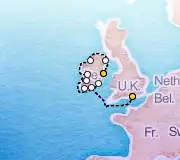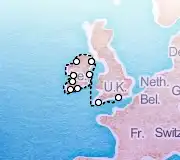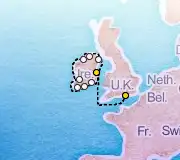Dublin Port is Ireland's largest and busiest seaport, situated at the mouth of the River Liffey on the country's east coast. It serves as a critical hub for both freight and passenger traffic, connecting Ireland with the UK and continental Europe. The port has grown significantly in recent years and features modern terminals capable of accommodating some of the world's largest cruise vessels.
For cruise passengers, Dublin Port is a primary gateway to Ireland's vibrant capital city. While the port itself is industrial, its proximity to the historic and cultural heart of Dublin makes it a popular stop on British Isles and Northern European itineraries, offering visitors immediate access to a wealth of attractions.
No visit to Dublin is complete without a tour of the Guinness Storehouse, where you can learn about the history of Ireland's most famous stout and enjoy a pint with panoramic city views from the Gravity Bar. It is located a short taxi or bus ride from the city center.
In the heart of the city, Trinity College Dublin offers a beautiful historic campus to explore. Its Old Library is home to the magnificent Book of Kells, an illuminated manuscript created by Celtic monks around 800 AD.
Another key historical site is Dublin Castle, which was the center of British rule in Ireland for centuries. Today, visitors can tour the State Apartments, Chapel Royal, and the excavated remains of the original Viking fortress.
Last updated on June 23, 2025
A popular day trip is to the charming coastal village of Howth, located about 40 minutes from the city center via the DART train. Visitors can enjoy the scenic cliff walk around Howth Head, explore the bustling fishing pier, and enjoy fresh seafood.
Slightly further afield lies the ancient monastic settlement of Glendalough in the Wicklow Mountains, approximately a 90-minute drive south of Dublin. Nestled in a glacial valley, this historic site features a well-preserved round tower and stunning natural scenery, though reaching it typically requires a shore excursion or pre-arranged transport.
To the north of Dublin, about an hour's drive away, is the UNESCO World Heritage Site of Brú na Bóinne, which contains the prehistoric passage tombs of Newgrange and Knowth, predating both Stonehenge and the Egyptian pyramids.
Last updated on June 23, 2025
Dublin Port is an industrial port located on the River Liffey, approximately 3-4 kilometers (about 2 miles) east of the city center. Due to the distance and the nature of the port area, it is not suitable for walking to the main tourist attractions. Most cruise lines provide shuttle bus services to drop passengers at a central point in the city, such as Merrion Square.
The cruise terminal itself is functional, designed for efficient processing rather than leisure. There are minimal amenities like shops or extensive restaurants directly at the pier. Taxis are readily available for passengers who prefer not to use the provided shuttles. Ships dock directly at the quay, so tendering is not typically required.
Last updated on June 23, 2025
The official currency used in Dublin is the Euro (€). While some tourist-heavy shops might display prices in other currencies for reference, payments must be made in Euros.
US Dollars are not accepted for transactions. It is best to use a credit card or withdraw Euros from an ATM upon arrival. ATMs are widespread throughout the city center and generally offer competitive exchange rates. Credit cards, particularly Visa and Mastercard, are accepted almost everywhere, with contactless payments being very common.
Last updated on June 23, 2025
Dublin is generally considered a safe city for tourists, and exploring independently is common and encouraged. However, as in any major European capital, visitors should exercise standard precautions. Be mindful of your surroundings and keep valuables secure, especially in crowded tourist areas like Temple Bar, O'Connell Street, and on public transport to avoid pickpockets.
It is wise to stay in well-lit, populated areas after dark. While there are no specific 'no-go' zones for tourists during the day, using common sense when walking at night is recommended. Emergency services can be reached by dialing 112 or 999.
Last updated on June 23, 2025
The cruise season in Dublin, from late spring to early autumn (April-October), features a mild but famously changeable maritime climate. Summer temperatures (June-August) typically range from 16-20°C (60-68°F), with long daylight hours. Spring and autumn are cooler and equally pleasant for sightseeing.
Rain is a possibility at any time of the year, but showers are often brief and pass quickly. It is highly advisable to dress in layers and pack a waterproof jacket, regardless of the forecast. This will allow you to adapt comfortably to the 'four seasons in one day' weather that Dublin can sometimes experience. Unlike the Caribbean, hurricane season is not a factor here.
Last updated on June 23, 2025
Cruise lines typically provide shuttle buses from the port to a central location like Merrion Square, as the port is not within walking distance of the city center. Taxis are also readily available at the cruise terminal for a direct journey to your destination.
Dublin has a comprehensive public transportation system managed by Transport for Ireland. This includes Dublin Bus, with numerous routes covering the city, and the Luas tram system. For exploring coastal towns, the DART (Dublin Area Rapid Transit) train is an excellent option. A Leap Card can be purchased for discounted travel across these services.
Last updated on June 23, 2025
Dublin offers excellent shopping opportunities, primarily centered around a few key areas. Grafton Street is a bustling, pedestrianized street famous for its upscale boutiques, department stores, and lively buskers. For more high-street brands and a local feel, head to Henry Street on the north side of the river.
For unique souvenirs, look for traditional Aran sweaters, Claddagh jewelry, and crafts in the shops around the Temple Bar area. Ireland is also famous for its whiskey, and numerous specialty shops offer a wide selection. Prices in stores are fixed. Non-EU visitors can take advantage of the Tax-Free Shopping scheme to claim a refund on the Value Added Tax (VAT) for qualifying purchases.
Last updated on June 23, 2025





Showing 4 ships in the area
No ships scheduled in port today.
Last updated on June 13, 2025
Taxis and dedicated cruise line shuttles are readily available at the cruise terminal for direct access to Dublin's city center. Public bus route 53 also serves the port area, offering a more budget-friendly option.
A short taxi or shuttle ride will take you to iconic attractions like the Guinness Storehouse, Trinity College to see the Book of Kells, and the historic Dublin Castle. The lively Temple Bar district is also easily accessible.
While options directly at the port are few, Dublin's city center, a short ride away, offers numerous pubs serving classic Irish stew, fresh fish and chips, and hearty pub fare. Try a traditional carvery lunch for a local experience.
The local currency is Euro (1 USD = 0.86 EUR). The local currency is the Euro (€). ATMs are widely available throughout Dublin city center for cash withdrawals; you can also exchange currency at banks or post offices (An Post).
Dublin's weather is famously changeable, even in summer (typically May-September for cruises); expect mild temperatures (15-20°C / 59-68°F) with a chance of rain. Pack layers, including a waterproof jacket and comfortable walking shoes.
While not a primary beach destination, Dollymount Strand on Bull Island is accessible via bus or taxi for a coastal walk. The fishing village of Howth, reachable by DART train, also offers scenic cliff walks and small coves.
Both cruise lines and independent operators offer excellent excursions, including guided city tours, visits to the Guinness Storehouse, or trips to nearby coastal towns like Howth or Malahide Castle. Booking popular tours in advance is recommended, especially during peak season.
Grafton Street and Henry Street are Dublin's main shopping thoroughfares. Popular local souvenirs include Aran sweaters, Claddagh rings, Irish whiskey, and Guinness-branded merchandise, often found in dedicated gift shops like Carrolls Irish Gifts.
The charming coastal villages of Howth (famous for seafood and cliff walks) and Malahide (with its historic castle) are easily reachable by DART train for a half-day trip. Further afield, organized tours often visit the scenic Wicklow Mountains and Glendalough.
Dublin Bay is a designated UNESCO Biosphere Reserve, highlighting its ecological importance right on the city's doorstep.
On average Dublin is rather affordable compared to other ports. Take a look at the graph below for the monthly average cost per day. Prices are approximately steady throughout the year.
Want to hear about the best deals and cruise tips every week? Sign up for our free weekly VIP Newsletter, customized exactly to your preferences!